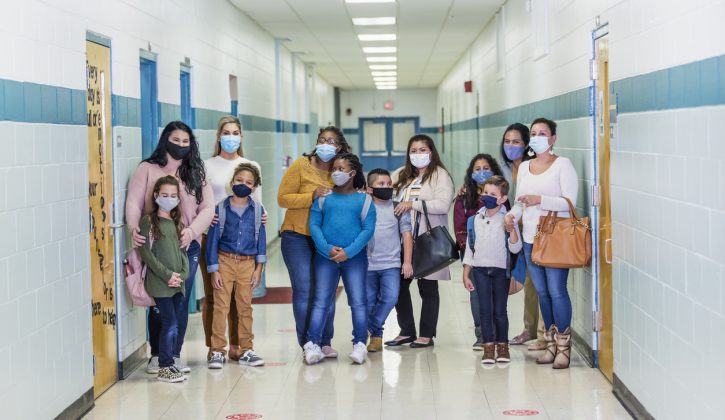No matter where you are in the country, this pandemic school year has been unlike any other, and that includes the past two. If you feel like you’re floundering, you’re not alone. As parents, we’re supposed to be steering this ship. And this year we’re no longer just in uncharted waters, we’re sailing through the Bermuda triangle on a daily basis, minus the sub-tropical climate, natch. So how do we help our kids and ourselves continue to navigate school? How can we support our children’s educational needs and help them feel safe. I think we can all agree feeling safe is the key here. The ship where they actually are safe sailed away a long time ago.
The fine people at the social-emotional learning (SEL) organization Peekapak reached out with these tips and advice for navigating the rest of this pandemic school year. It’s going to take a village, and Peekapak is your new friendly-neighbourhood resource.
How to Navigate the Rest of This Ever-Changing Pandemic School Year
The Importance of Parent Involvement:
The transition between in-person and virtual learning requires the alignment of teachers and parents. When students attend class, they are being supported by an encouraging and engaging teacher throughout the day. When the same support is provided at home, studies show students are likely to demonstrate higher social functioning, and fewer behavioural problems. So how exactly can parents get involved?
Parent involvement can include reaching out to teachers about current/upcoming lesson plans to reinforce main ideas at home, expressing a genuine interest in a student’s day, becoming familiar with learning platforms students are using, or becoming directly involved on the parent council. Reaching out to your child’s teacher is always a great place to start!
1. Implementing Routines
Has anyone’s routine stayed consistent over the past two years? Absolutely not. So we understand how difficult it can be to create routines in the home. However, there are ways to create consistency on days where everything may be up in the air. A good daily routine is well planned; everyone knows and respects their roles. For example, your child is aware they have
to do the dishes while their sibling is required to sweep the floor after dinner. During a period of transition between virtual and in-person learning, having static routines can help create healthy habits. Regardless of the type of school delivery, having a regular bedtime, waking up at the same time (even if you don’t have to catch the bus), or meal schedules help create the routine children unconsciously need.
2. Creating Designated Work Areas
Whether it’s getting ready for the bus, making breakfast, or sitting down for a day of virtual learning, we are all too familiar with the struggles of having a full house. Having designated work areas for children (and parents) is crucial in developing a healthy routine and being successful. We realize sometimes having a desk and chair spaced out around the house for
everyone is laughable – but having a designated workspace for children can simply be a pillow on their lap in bed, in the corner of the couch, or at the dinner table! Especially during virtual learning, having specific areas for children to associate with ‘work’ is going to increase their chances for success. You can use our lesson on creating a special space for children.
3. Stay Positive!
Whether you’re aware of it or not, children mirror their parent’s behaviour. Moreover, “children, especially young children, look to their parents to figure out how to react to new or intimidating situations. If their parents seem skeptical or defeated, then they’re likely to follow suit.” To leverage this information, parents should demonstrate actions they would like to see from their children. So, make your bed, stay loyal to your habits, prioritize relationships, and have a growth mindset! Most importantly, demonstrating excitement about education is likely to influence the child’s attitude towards learning, and help them through the rest of this pandemic school year. When their superhero parent is excited about math, they are more likely to be engaged in the topic as well!
4. Leveraging SEL Programs
I know by now you are probably sick of talking about the pandemic, but we can not ignore the impact this pandemic school year has had on students. Being thrown in and out of in-person learning, distance from friends, isolation, pandemic anxiety – the list goes on. Students need to learn a healthy way to deal with their emotions as a result of those barriers. This is where the importance of social-emotional learning (SEL) is introduced. Teaching healthy ways for children to manage their emotions at school has many benefits. This furthers their ability to form healthy relationships in the classroom, develop socially, and develop a healthy foundation of emotion regulation as they enter developmental years.
Peekapak is an SEL organization that provides ready-to-use learning resources for Pre-K to grade 8 and is compatible with remote, in-person or hybrid learning. Using storytelling, reinforcing activities, digital learning games, and emotion check-ins, Peekapak’s learning platform is able to use grade-appropriate material to teach important soft skills such as empathy, self-regulation, and decision-making skills. If you are looking for ways to incorporate social-emotional learning into your classroom in the context of the pandemic, Peekapak has created eight specialized SEL pandemic lessons that teach children about the pandemic and help them to address feelings of worry, frustration, boredom, and much more. These lessons can be found here.
Tagged under: pandemic,pandemic parenting,virtual school






